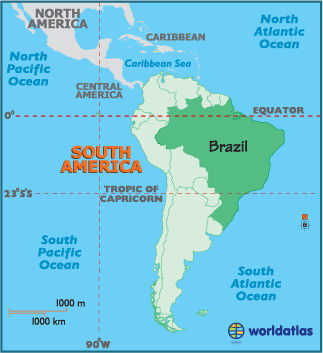Location:
Location can be defined in two ways, absolute
and relative. Absolute location is the exact location, which can be described
by looking at longitude and latitude or the street address of a specific place.
Brazils absolute location is 15.7833 degrees south, 47.8667 degrees west. The
relative location can be given in numerous ways as you are comparing two
places. For example, Sao Paulo, Brazil is 11042.30 km relative to Vancouver,
Canada.
Place:
Place can be defined by looking at human
characteristics or physical characteristics. Human characteristics can be
described by looking at the main language or population. Portuguese is the
first language of Brazil, spoken by 99% of the countries population. Brazil has
a population of 203,120,816 people. Physical characteristics would include
landforms, climate, wild life, etc. Brazil is divided into five primary
geographic areas. The northern Guiana Highlands, Brazilian Highlands, Amazon
Basin, Brazilian Shield and Mato Grosso Plateau and Pantanal. Guiana
Highlands consist flat-topped mountains extending east-to-west across the north
of Brazil. The Brazilian Highlands occupy about half of the nation’s landmass.
It consists of rolling hills, cliffs, plateaus, and rocket outcroppings. The
Amazon Basin is the largest tropical rainforest in the world. It is a home to
countless species of rare flora and fauna. At the heart of this basin is the
Amazon River, which drains almost half of South America and carries a higher
volume of water than any other river in the world. The Brazilian Shield
contains hundreds of northward-flowing rivers and streams and as the land rises
higher to the south it transitions into the Mato Grosso Plateau. This area
receives less precipitation compared to the Amazon rainforest. Pantanal consists
of the world’s largest freshwater wetland. It floods for months which makes it
an enormous nursery for marine life. The climate of Brazil is influence by
several factors, including temperature, rainfall, humidity, winds, and
atmospheric pressure. These factors are influenced by factors such as altitude,
latitude, and vegetation. There are five primary climates present in Brazil;
equatorial climate, tropical climate, semi-arid climate, oceanic climate, and
sub-tropical climate.
Regions:
Brazil is officially divided into five regions;
North, Northeast, Centre-West, Southeast and South.
· North
(largest region)
Climate: high temperature and high rainfall
levels
Population: second least populated region
(16,000,000)
· Northeast
(largest coastline of the country)
Climate: Does not present one type of climate,
but four different ones. They consist of semi-arid climate, tropical, humid,
and humid equatorial climate.
Population: 53,000,000
· Centre-west
(second largest region)
Climate: Semi-humid climate, well defined as
wet summers (March & October) and dry climate during winter
(April-September).
Population: 14,400,000
· Southeast
(vital center of the country)
Climate: Tropical climate, two well-defines
seasons would be summer (heavy rain) and winter (very dry).
Population: 84,400,000
· South
(smallest area of the Brazilian territory)
Climate: The region is entirely below the
Tropic of Capricorn; therefore it is the coldest region of Brazil. At higher
elevations there is occasionally snowfall and frosts.
Population: 27,700,000
Movement:
Brazils cities are very crowded therefore
buildings are very close together. People rely on bikes, cars and buses to get
from one place to another depending on the distance. The Amazon Rainforest
provides many medicines not only within the country but the whole world.
Medicine is probably the major export of Brazil. Brazilians speak Portuguese
and are very proud to do so. They communicate as we do, through technology.
Human-Environment
Interaction:
Brazil has to adapt to the heat and humidity.
The northern part of Brazil is on the equator and by the Atlantic Ocean. The
people adapt to this by wearing suitable clothing and having air-conditioned
houses and buildings. They need the Amazon Rainforest for medication for bugs
and sickness from the heat. The heat and humidity leaves Brazil dependent on
energy, water and the rainforest.
